Dermal Ground And Vascular Tissue
The main difference between dermal, vascular, and footing tissue is that the dermal tissue is composed of epidermis and periderm. But, the vascular tissue is equanimous of xylem and phloem. Meanwhile, ground tissue is composed of parenchyma tissue, collenchyma tissue, and sclerenchyma tissue. Furthermore, dermal tissue provides protection and prevents h2o loss; vascular tissue conducts water and nutrient, while ground tissue undergoes photosynthesis, food storage, regeneration, support, and protection.
In brief, dermal, vascular, and ground tissue are three tissue systems of plants. Generally, they organize into different functional layers in the stem, leaves, roots, and other parts of the jail cell.
Key Areas Covered
i. What is Dermal Tissue
– Definition, Anatomy, Function
2. What is Vascular Tissue
– Definition, Anatomy, Function
3. What is Footing Tissue
– Definition, Anatomy, Function
four. What are the Similarities Between Dermal Vascular and Ground Tissue
– Outline of Common Features
5. What is the Deviation Betwixt Dermal Vascular and Ground Tissue
– Comparison of Key Differences
Key Terms
Collenchyma, Dermal Tissue, Epidermis, Basis Tissue, Parenchyma, Phloem, Sclerenchyma, Vascular Tissue, Xylem 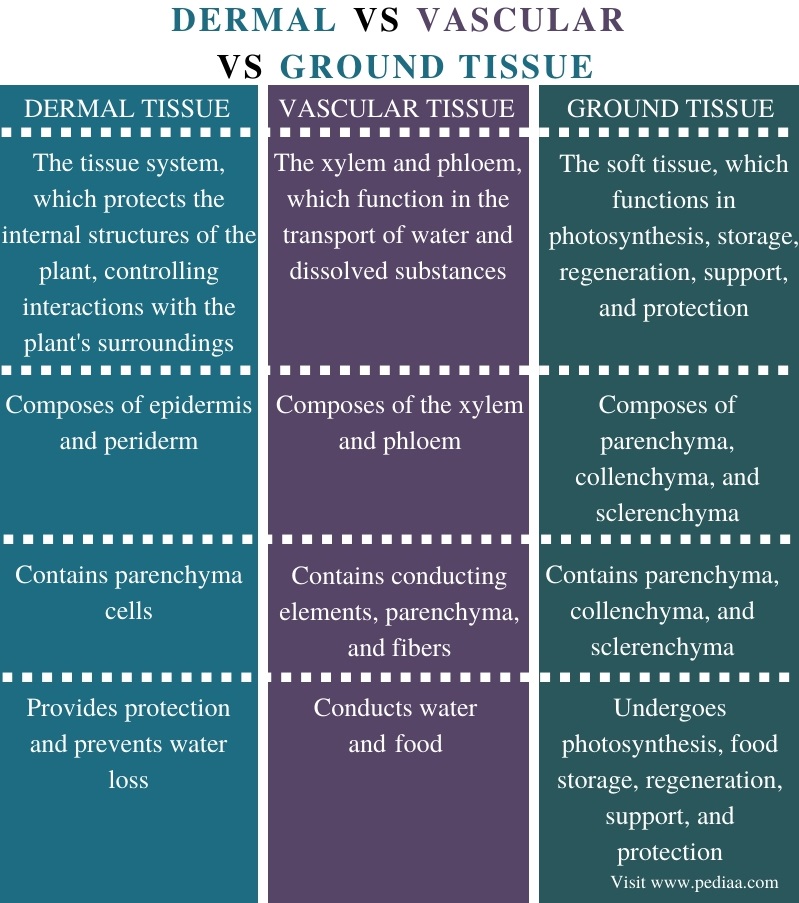
What is Dermal Tissue
Dermal tissue is the external tissue responsible for protecting the soft tissue inside the plant trunk. Likewise, it controls the interactions of the plat with the surrounding environment. Further, there are 2 types of dermal tissue, occurring in plants at different developmental stages. They are the epidermis and the periderm.
Epidermis
The epidermis is a single layer of closely-packed, parenchymatous cells. Its office is to comprehend the underlying tissues. Therefore, it serves as the skin of the plant. In improver to that, information technology secrets a waxy substance called the cuticle, which coats, waterproofs, and protects the above-ground parts of plants. On that business relationship, the cuticle prevents abrasions, water loss, infections, and damages from toxins, respectively.
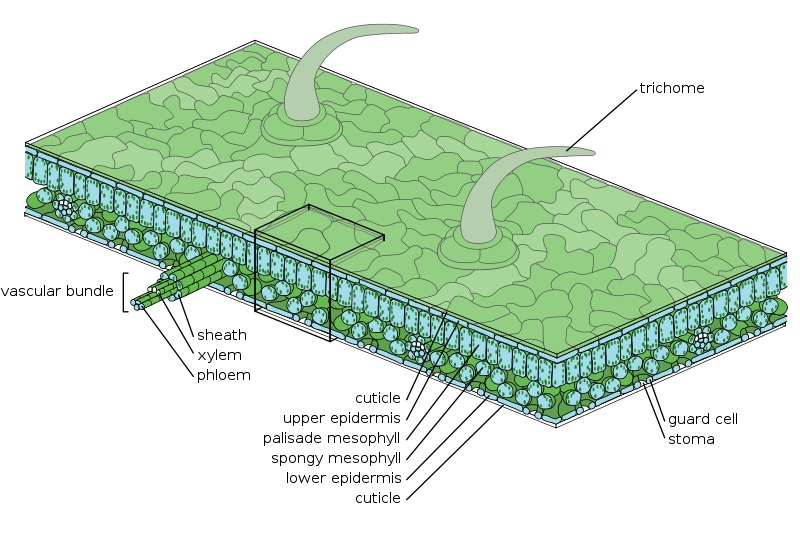
Figure i: Leaf Epidermis
Likewise, the epidermis contains several types of specialized cells, including pavement cells, guard cells, and hair cells. Of these, pavement cells are large, irregular-shaped parenchyma with no chloroplasts. Also, they brand up most of the epidermis. Meanwhile, baby-sit cells are pairs of bean-shaped, sclerenchyma cells that groovy and shrink by osmosis to open and shut stomata . Here, stomata are the tiny pores, which control the commutation of oxygen and carbon dioxide gases and the release of h2o vapor. Significantly, the lower surface of leaves contains the highest number of stomata; 100,000 stomata per square centimeter.
Apart from those two cells, the third is the hair cells. And, three types of hair cells occur; epidermal hairs, glandular hairs, and root hairs. Part-wise, epidermal hairs lower the water loss past decreasing the flow of air over the plant surface, while glandular hairs foreclose herbivory by storing substances that are harmful to insects. Meantime, root hairs increase water uptake by increasing the expanse of the cell.
Periderm
While epidermis is the primary plant tissue, periderm is the secondary tissue, which replaces the epidermis in the stalk and roots during the secondary growth of woody plants. Furthermore, periderm composes of 3 layers of cells, initiated from the cork cambium or phellogen. Of these, the cork cambium produces cork cells outward and phelloderm inwards.
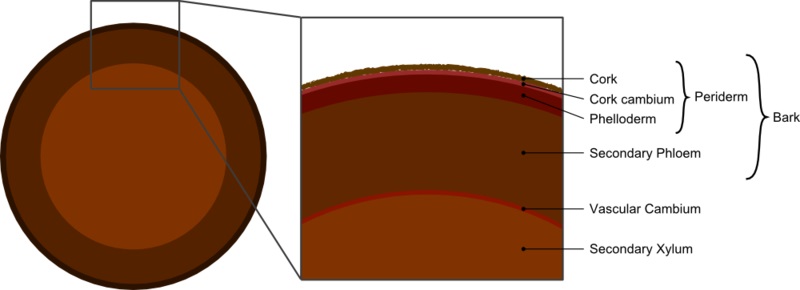
Figure ii: Periderm
Moreover, cork cells undergo secondary wall-thickening with suberin depositions, while phelloderm contains living cells. As well, it provides protection to the internal tissue while permitting gas exchange.
What is Vascular Tissue
Vascular tissue includes xylem and phloem, conducting respectively water and dissolved food throughout the plant. In the stalk, they adapt in vascular bundles, the distinct strands, which run in length-wise. Specifically, in the dicot stem, vascular bundles occur in a ring while in the monocot stem, they are scattered.
Xylem
Xylem is the type of vascular tissue responsible for conducting h2o and dissolved minerals. As well, information technology provides mechanical back up to the stem. Furthermore, the 2 types of conducting elements of the xylem are the tracheids and vessel elements. Of these, tracheids are long and accept thicker secondary cell walls. But, vessel elements are short and have thinner jail cell walls. In addition to that, xylem contains parenchyma cells and fibers.
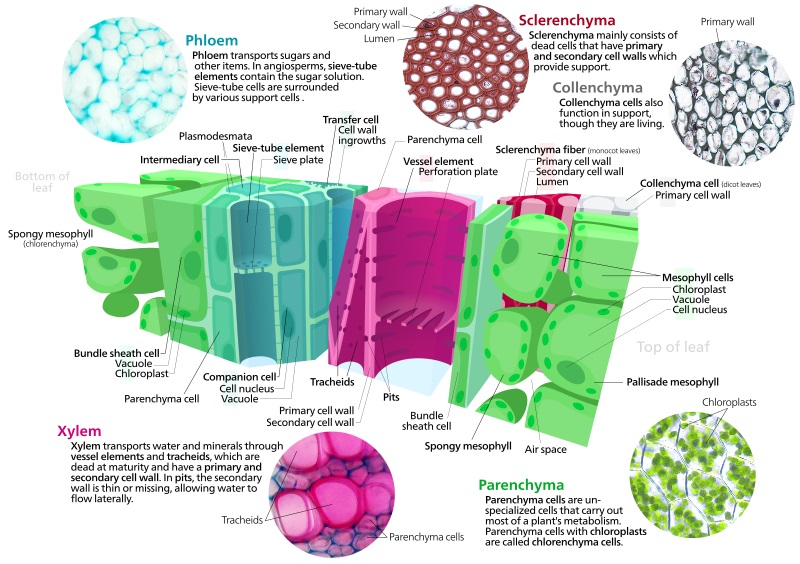
Effigy 3: Xylem and Phloem
Phloem
Phloem is the blazon of vascular tissue responsible for conducting food from leaves to the unlike parts of the plant. Here, the conducting component is the sieve-tube cell and its companion cell, which are arranged terminate to end to make up a long sieve tube. Furthermore, while the sieve-tube cells are alive, the nucleus of information technology is disintegrated. Therefore, the companion cell provides metabolic back up to the sieve-tube cells. Similarly, phloem also contains parenchyma and fibers.
What is Ground Tissue
Ground tissue contains the cells produced past ground meristems. And, these cells include parenchyma, collenchyma, and sclerenchyma. Furthermore, the chief function of footing tissue is to fill up the spaces between the vascular and dermal tissue. Apart from that, the cells of the ground tissue are specialized for various functions including photosynthesis, storage, regeneration, support, and protection.
Parenchyma
Parenchyma cells are living cells that perform almost of the constitute's metabolism. Therefore, they have only the primary cell wall thickening by cellulose. Besides, they have the ability to undergo proliferation. Functionally, the parenchyma in leaves undergoes photosynthesis. In addition to that, parenchyma serves as a storage tissue and undergoes healing and tissue regeneration.
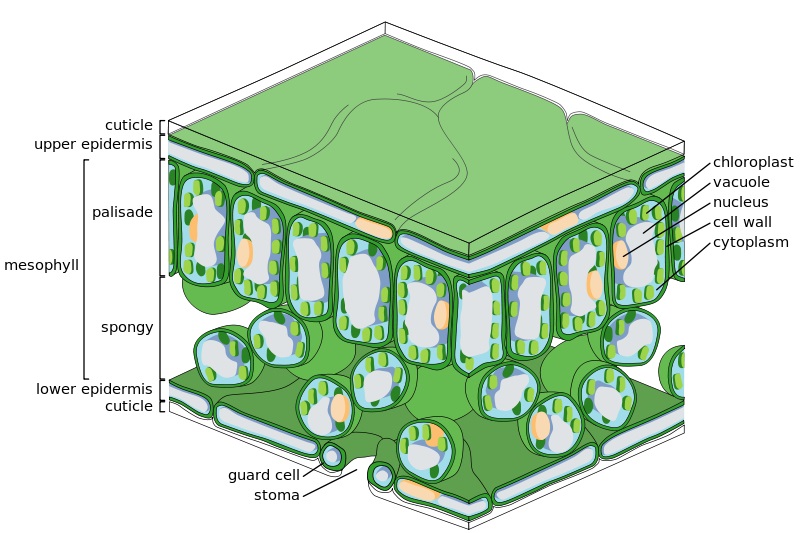
Figure 4: Mesophyll contains Photosynthetic Parenchyma
Collenchyma
Collenchyma cells are living cells with uneven cell wall thickenings of cellulose and pectin. Also, they have a polygonal shape, and their function is to provide structural support to the young parts of the plant, including stems, roots, and petioles.
Sclerenchyma
On the other hand, sclerenchyma is non-living cells with jail cell wall thickenings of cellulose, hemicellulose, and lignin. Too, there are two types of sclerenchyma cells; they are the fibers and sclereid cells. Typically, fiber cells are long cells that occur in bundles. And, they occur in xylem and phloem. Meanwhile, sclereid cells have highly thickened prison cell walls with lignin. Also, they occur in modest bundles.
Besides, the main function of sclerenchyma is to provide structural support to the different parts of the plant.
Similarities Betwixt Dermal Vascular and Ground Tissue
- Dermal, vascular, and ground tissue are three tissue systems of a Constitute.
- As well, all 3 are permanent tissues, which differentiate and specialize them from the cells produced past the meristem.
- Therefore, they perform specialized functions by losing their ability to dived farther.
- As well, these three tissues occur in the stalk, leaves, and roots.
Difference Betwixt Dermal Vascular and Ground Tissue
Definition
Dermal tissue refers to the tissue organization that protects the internal structures of the plant and control interactions with the plant's surroundings. Meanwhile, vascular tissue refers to the xylem and phloem, whose role is to transport water and dissolved substances. On the other manus, ground tissue refers to the soft tissue that functions in photosynthesis, storage, regeneration, support, and protection.
Component Tissue
While dermal tissue composes of epidermis and periderm, vascular tissue composes of the xylem and phloem. Meantime, ground tissue composes of parenchyma, collenchyma, and sclerenchyma.
Cell Types
Dermal tissue contains parenchyma cells. Vascular tissue contains conducting elements, parenchyma, and fibers, but ground tissue contains parenchyma, collenchyma, and sclerenchyma.
Function
Dermal tissue provides protection and prevents water loss. Vascular tissue conducts water and food, while ground tissue undergoes photosynthesis, food storage, regeneration, support, and protection.
Conclusion
Dermal tissue is the tissue responsible for protecting the internal, soft tissues of the plant. It is composed of epidermis and periderm. As well, the function of the dermal tissue is to provide protection to the internal tissue while preventing water loss. On the other mitt, the vascular tissue is composed of xylem and phloem, which are the conducting tissues of the constitute. And, they transport water and dissolved nutrient, respectively. Meanwhile, ground tissue composes parenchyma, collenchyma, and sclerenchyma cells, filling the spaces betwixt vascular and dermal tissue. In addition to that, they undergo photosynthesis, storage, and regeneration. Therefore, the main difference betwixt dermal, vascular, and ground tissue is the blazon of cells present and their functions.
References:
1. "Concept iii: Plant Tissue Systems|BioCoach Activity."Pearson – The Biology Place, Available Here.
Image Courtesy:
1. "Leaf Structure" Past Zephyris – Own work (CC Past-SA 3.0) via Commons Wikimedia
2. "Tree secondary components diagram" Автор: Brer Lappin (Public Domain) via Commons Wikimedia
3. "Plant cell types" Past Kelvinsong – Own work (CC BY-SA 3.0) via Eatables Wikimedia
iv. "Foliage Tissue Structure" Past Zephyris – Own work (CC Past-SA iii.0) via Commons Wikimedia

Dermal Ground And Vascular Tissue,
Source: https://pediaa.com/what-is-the-difference-between-dermal-vascular-and-ground-tissue/
Posted by: costellotink1947.blogspot.com


0 Response to "Dermal Ground And Vascular Tissue"
Post a Comment